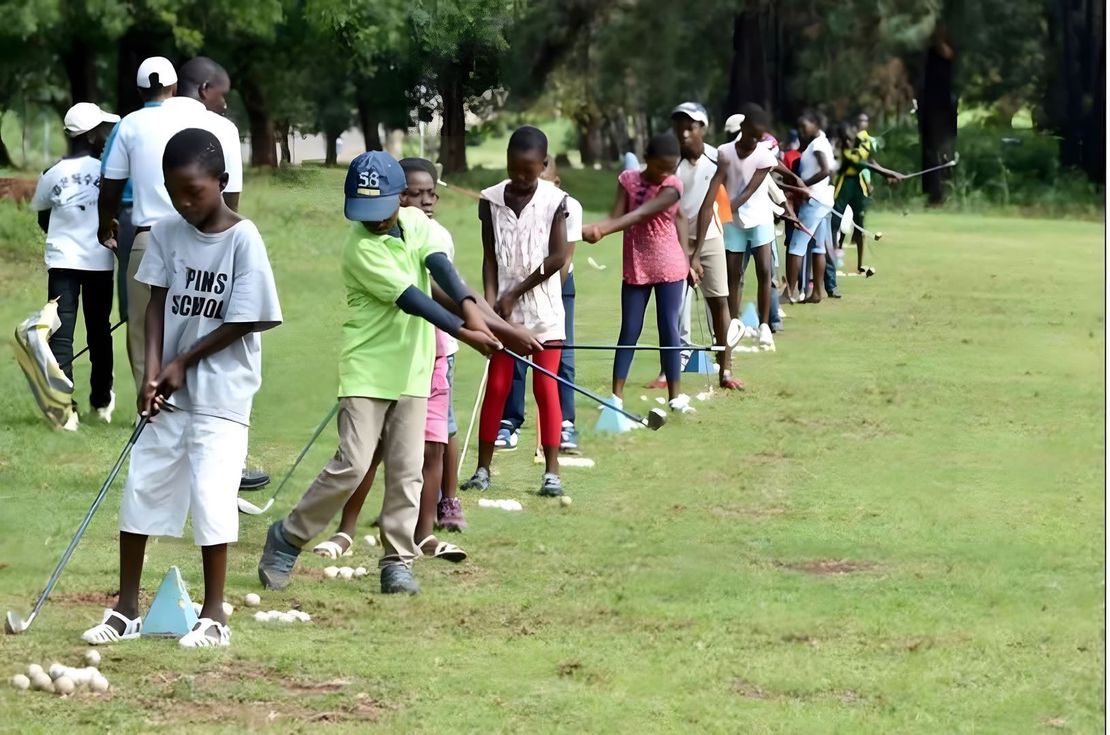
Embracing Inclusivity: Exploring Gender Differences in Golf
- Elena Rodriguez
- Golf , Inclusivity
- June 27, 2024
Table of Contents
As a former European Women’s Tour competitor turned writer and coach, I’ve experienced the beauty and challenges of golf firsthand. This sport has a unique way of both uniting and testing us, pushing us to excel within the boundaries of its time-honoured rules. Over the years, these rules have remained mainly gender-neutral, emphasising fairness and integrity in every stroke. However, the true spirit of golf extends beyond these regulations, adapting subtly to accommodate and welcome all who wish to play, regardless of gender.
Today, as we strive towards greater inclusivity, it’s essential to understand how golf adheres to a universal set of rules and flexibly adjusts aspects like course design and equipment to enhance accessibility for everyone. This article aims to shed light on these adaptations, affirming that golf is a sport for all, committed to evolving with its players. By embracing diversity and promoting equity, we can ensure that golf remains a beloved pastime that enriches everyone’s lives, inviting players from all walks of life to share in its joys and challenges.
I distinctly remember being injured just before a major tournament; everyone around me insisted that I shouldn’t compete. I felt most bad when I was injured before the tournament, and everyone was against my participation. I recall that I didn’t win the game, but I enjoyed some parts and proved to them that determination and passion can often outweigh physical constraints. It was a moment that tested my resilience and deepened my love for the game.
Understanding the Rules
Golf prides itself on a rich tradition where the fundamental rules apply universally, regardless of the player’s gender. This foundational principle ensures that anyone, anywhere, can play the game under a unified set of regulations, maintaining the sport’s integrity and competitive fairness. However, a deeper dive into these rules reveals subtle yet crucial nuances and adaptations that recognise and accommodate players’ different needs and abilities.
Universal Rules and Gender Neutrality
The basic rules of golf, governed globally by the Royal and Ancient (R&A) and the United States Golf Association (USGA), are designed to be gender-neutral. These rules cover aspects like the structure of play, scoring, equipment standards, and etiquette on the course. For instance, the rules dictate that all players must play the ball as it lies, use no more than fourteen clubs, and not touch the ground in a hazard before making a stroke. These standards ensure a level playing field where gender does not dictate the basic approach to the game.
Adaptations in Competition Settings
While the foundational rules remain consistent, adaptations often occur in the organisation and setup of competitions to foster inclusivity and competitiveness. For instance, adjustments such as different tee placements for men and women are standard in professional and amateur tournaments. These adjustments acknowledge the average physiological differences between genders, particularly in driving distance, without altering the fundamental challenge of the course. Such adaptations help tailor the course’s difficulty to match the diverse capabilities of competitors effectively.
Handicapping: Bridging the Performance Gap
The handicapping system is another area where golf shows its inclusivity. This system allows players of varying abilities and genders to compete equitably. Handicaps are calculated slightly differently for men and women, considering the average scoring differences and playing conditions specific to each gender. This nuanced approach ensures that the sport is fair and challenging for everyone, promoting a competitive balance.
Local Rules and Gender Considerations
At the local level, clubs may implement specific rules enhancing inclusivity. For example, certain local rules allow for alternative play or modifications to the course during league play or special events to encourage participation from a broader range of players. These regional adaptations demonstrate how golf communities can embrace diversity within the framework of global rules.
Course Design and Setup
In golf, the design and setup of the course play pivotal roles in tailoring the game to accommodate players of different genders. These adjustments ensure that the course offers a fair challenge to all participants, aligning with the sport’s inclusive values.
Tee Box Placement
One of the most visible adaptations in golf course design is the placement of tee boxes. Men, women, and junior players often use different tees positioned to reflect the average driving distances typical of each group. This is not merely a matter of making the game more accessible; it’s about adjusting the challenge so that each hole presents a strategic test appropriately scaled to the player’s ability. For instance, women’s tees are generally positioned to reduce the hole’s length, helping to equalise the playing field regarding the power and distance achievable by different genders.
Course Length and Difficulty
The overall length of a golf course can vary significantly between professional men’s and women’s tournaments. Women’s courses are typically shorter than men’s, but this does not imply a reduction in difficulty. Strategic placements of hazards, such as bunkers, water bodies, and rough areas, are thoughtfully considered to maintain a challenging game for all players. This approach ensures that the course remains challenging and engaging, regardless of the tee from which one plays.
Adjustments for Major Tournaments
During major championships and professional tournaments, course setups are meticulously planned to test the skills of the world’s best players. For women’s tournaments, this might mean different pin placements or altered fairway widths that require precise shot-making and strategic thinking. These subtle but significant adjustments cater to different playing styles and highlight the athletes’ skill levels, making the competition exciting and fair.
Inclusive Design Features
Beyond competitive adjustments, many modern golf courses incorporate design features that enhance accessibility for players of all ages and abilities. This includes smoother cart paths, more accessible clubhouse facilities, and alternative playing formats, such as shorter three- or six-hole loops catering to players with limited mobility or those new to the game. These features are part of a broader movement towards making golf more inclusive, ensuring that everyone can enjoy the sport, regardless of their physical capabilities or experience level.
Equipment Adaptations
The design and selection of golf equipment are crucial for accommodating players of different genders, providing each individual with the tools needed to optimise their performance on the course. This section explores how golf clubs, balls, and other equipment are tailored to suit various physical strengths and playing styles.
Golf Clubs: Customisation for Performance
Golf clubs are often customised to suit the physical characteristics and swing styles of different players. Women’s golf clubs, for instance, typically feature lighter shafts, smaller grips, and shorter lengths than men’s clubs. This customisation accounts for the general differences in height, hand size, and strength between genders, allowing for more comfortable and effective swings. Additionally, the club heads on women’s clubs might have higher loft angles, aiding players with slower swing speeds to achieve better lift and distance.
Golf Balls: Optimised for Different Swing Speeds
Manufacturers also produce golf balls that are optimised for different swing speeds, which tend to vary between genders. Women’s golf balls are generally designed to perform better with lower swing speeds, offering greater distance and improved flight characteristics. These balls typically have a softer compression, which helps to maximise the energy transfer during impact, especially when players do not generate the same force as their male counterparts.
Technological Integration in Equipment Design
Advancements in technology have greatly enhanced the customisation of golf equipment. Modern tools like swing analysers and performance-tracking systems allow manufacturers and coaches to tailor equipment more precisely to individual needs. These technologies can analyse everything from swing speed and ball spin to launch angle and carry distance, providing data that helps fine-tune equipment choices for each player, regardless of gender.
Clothing and Accessories
Inclusivity in golf extends to clothing and accessories, which are designed not only for function but also for comfort and style, respecting players’ diverse identities and preferences. Women’s golf apparel, for example, combines fashion with functionality, offering options that are both practical for play and reflective of personal style. Moreover, manufacturers are increasingly mindful of designing apparel that accommodates all body types, promoting a more inclusive environment on the course.
Barriers and Challenges
Despite the strides toward inclusivity, golf faces persistent barriers that can affect access and enjoyment of the sport for different genders. This section explores these challenges and discusses initiatives aimed at overcoming them to make golf more accessible to everyone.
Social and Cultural Barriers
Historically, golf has been perceived as a sport for the affluent, often dominated by men, which has created cultural and social barriers that deter broader participation. Women and people from diverse backgrounds sometimes face unwelcoming environments or feel marginalised due to longstanding traditions and norms in clubs and courses. Addressing these challenges requires a cultural shift, promoting a more welcoming atmosphere that actively encourages participation from all demographics.
Economic Barriers
Golf’s reputation as a sport primarily for the affluent can often deter new players due to the perceived high costs of equipment, apparel, and club memberships. Addressing these economic barriers is crucial to making the sport more inclusive and accessible. Initiatives such as subsidized rates and equipment rental options are essential for lowering the entry and maintenance costs for newcomers. Discover more about these challenges and the stereotype of golf as a sport for reach in our comprehensive analysis.
Physical Accessibility
Accessibility remains a significant challenge, especially for players with disabilities or limited mobility. While modern courses are improving, widespread adaptation of facilities is still needed. This includes creating more accessible course designs, improving clubhouse facilities, and ensuring that golf carts and other mobility aids are available to those who need them.
Gender-Specific Challenges
Women and non-binary individuals may face challenges such as limited tournament opportunities, disparities in prize money, and a lack of representation in leadership roles within golf organisations. Initiatives like women-only clinics, mentorship programs, and targeted outreach can help address these disparities and encourage more women and non-binary individuals to participate in and lead within the sport.
Promoting Youth Involvement
Engaging young people from diverse backgrounds is crucial for the future of golf. Schools and community programs can play pivotal roles in introducing golf to children as a fun and accessible sport. By integrating golf into physical education programs and partnering with local youth organisations, the golf community can foster a more inclusive next generation of players.

Promoting Equity and Inclusion
It is crucial to actively promote equity and inclusion to ensure that golf remains a sport that welcomes and values all players. This section outlines effective strategies and initiatives that are helping to transform golf into a more inclusive sport.
Inclusive Policies and Practices
Golf clubs and organisations increasingly recognise the need for explicit policies promoting gender equity and inclusivity. This includes establishing clear anti-discrimination policies, creating inclusive membership options, and ensuring that club leadership reflects the diversity of its membership. Such policies create a more welcoming environment and set a standard for conduct and interaction among members.
Representation Matters
Visibility and representation are powerful tools for change. Showcasing successful female and non-binary golfers and promoting diverse role models can inspire a broader audience to take up golf. Media coverage that equally highlights women’s and men’s golf, sharing their stories and successes, is crucial in changing perceptions and encouraging participation from underrepresented groups.
Community Engagement and Partnerships
Building partnerships with local schools, community groups, and non-profits can bring golf to a broader audience. These partnerships can facilitate programs introducing golf to people who might not otherwise consider it accessible, such as inner-city youth or individuals from underprivileged backgrounds. Community engagement also helps to break down the notion that golf is exclusive to specific demographics.
Training and Development Programs
Offering training programs that cater to beginners and advanced players alike can make golf more accessible. These programs can focus on skills development, understanding of the sport, and even career opportunities within golf. By providing these resources, golf clubs and organisations can help demystify the sport and make it more approachable for everyone.
Celebrating and Supporting Inclusivity Initiatives
Supporting initiatives that promote inclusivity, such as tournaments that feature players of all genders and abilities, can make a significant impact. Celebrating these events and the people organising them raises awareness and shows the golf community’s commitment to inclusivity. Funding and support for such initiatives are essential for their success and sustainability.
The Future of Golf
As we look toward the future, golf’s evolution as an inclusive sport offers both challenges and exciting opportunities. This final section explores potential developments in golf and how continued efforts toward inclusivity will shape the sport for future generations.
Technological Advancements
The role of technology in golf continues to expand, from sophisticated equipment fittings to virtual reality simulations that make learning the game more accessible and engaging. Future technological innovations are expected to personalise the golfing experience further, making it easier for players of all abilities and backgrounds to improve their skills and enjoy the game.
Globalisation of Golf
Golf is becoming increasingly global, with many tournaments and players emerging from non-traditional golf countries. This globalisation presents a unique opportunity to infuse the sport with diverse cultural perspectives, enhancing its appeal and accessibility worldwide. Embracing this diversity can lead to more inclusive golf policies and practices that resonate globally.
Environmental Sustainability
As concerns about environmental sustainability grow, golf courses and the sport must adapt. Future designs and maintenance practices will likely emphasise sustainability, from water conservation to eco-friendly materials. These changes protect the environment and position golf as a forward-thinking, responsible sport.
Expanding Youth Programs
Investing in youth golf programs is essential for the sport’s growth and diversity. By making golf accessible and enjoyable for young players, these programs can cultivate a lifelong passion for the sport. Future initiatives should focus on inclusivity, ensuring that children of all backgrounds feel welcomed and valued in the golf community.
Ongoing Dialogue and Policy Revisions
The conversation about inclusivity in golf is ongoing. As societal attitudes evolve, so too must golf’s policies and practices. Continuous dialogue among players, officials, and fans is crucial for identifying areas for improvement and implementing changes that reflect the sport’s values of fairness and respect.
Conclusion
As we’ve explored throughout this article, golf is more than just a game of skill and precision—it’s a platform for promoting inclusivity and celebrating diversity. Adaptations in rules, course design, equipment, and practices all contribute to making golf accessible and enjoyable for players of all genders and backgrounds. By understanding these adjustments and actively promoting inclusive policies, the golf community can ensure that the sport remains welcoming for everyone.
The journey towards total inclusivity in golf is ongoing. While significant progress has been made, continuous efforts are necessary to address remaining barriers and to embrace new opportunities for growth and improvement. Each step taken towards inclusivity not only enhances the sport itself but also enriches the community that surrounds it. Golf’s potential to unite people across diverse backgrounds is immense, and by fostering an environment of equality and respect, we can all contribute to a brighter, more inclusive future for the sport.
In closing, let us remember that golf’s essence lies in its ability to challenge us, teach us, and connect us. As we move forward, may we continue to swing not just with precision but with purpose—striving to make every aspect of golf reflect the values we cherish: inclusivity, respect, and fairness. This is not just the future of golf; it’s the future we build together, on and off the green.


